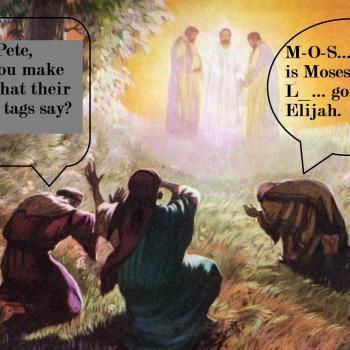 Hebrews 9 is the source of a couple of popular “memory verses” in conservative Evangelical circles. It was interesting to explore it in my Sunday school class today in a way that got at some key questions, both in terms of the exploration of the meaning of the text in its original context, and how it might be appropriated and used today.
Hebrews 9 is the source of a couple of popular “memory verses” in conservative Evangelical circles. It was interesting to explore it in my Sunday school class today in a way that got at some key questions, both in terms of the exploration of the meaning of the text in its original context, and how it might be appropriated and used today.
The core imagery related to the author's understanding of the significance of Jesus' death is drawn from Leviticus, and specifically the Day of Atonement (Yom Kippur) ritual. Jesus is not understood in terms of the scapegoat to which sins were thought to be transferred, which was then unsuitable for use as a sacrifice and was released in the wilderness. Instead, Jesus' death is understood in terms of the other goat, the blood of which was used to purify the “Holy of Holies.”
This leads to a key question: why should the most holy place need to be purified? Leviticus 16:16 gives the answer explicitly (and I am grateful to Gordon Wenham's commentary on Leviticus for making this and many other aspects of the text clearer than they might have otherwise seemed). The blood in the Day of Atonement ritual is thought to purify the most holy place from the sin and uncleanness of the people, so that God could dwell there in their midst.
How then does the author apply this to the death of Jesus? Jesus is depicted as purifying the real, heavenly sanctuary with his blood, allowing human beings to enter into the heavenly place and dwell in the very presence of God.
None of this can be understood literally. To suggest that Jesus, after his death, somehow literally ascended to heaven with his literal blood with him and applied it to a literal tabernacle in heaven is to turn symbol into silliness.
When we ask what the sacrificial metaphor is conveying at its core level, it turns out to be the same thing that Paul emphasizes in 2 Corinthians 5 using a different metaphor, that of dying and rising to newness of life in union with Christ. In both cases, despite the different metaphors, the core message turns out to be expressed in terms of reconciliation between God and human beings, with God being the initiator in making this possible.
The biggest problem I have with a lot of contemporary Christian talk about the atonement is that it depicts God as the problem, one whose hands are tied for this or that reason, with Jesus' death as the only way to get God to forgive us.
The New Testament emphasis is thoroughly different. It focuses on human injustice, lack of compassion, hatred, mercilessness, ruthlessness, jealousy, and all the other things that we know we are capable of and which make us ashamed. And it focuses on God as wanting to free us from those things and transform our lives.
However one may think about God, or the death of Jesus, in the present day, there is no reason that we cannot preserve the core emphasis on our need for inner transformation and the genuine possibility of experiencing it. And for Christians, we often find the inspiration and challenge to experience those things in our contemplation of a crucified Messiah, one who overcomes evil not by destroying and punishing but by seeking reconciliation, even at the cost of his own life.
Next week in my Sunday school class we'll continue to reflect on this subject, focusing on whether and to what extent the language the author of Hebrews used to clarify the significance of Jesus' death in symbolic terms (animal sacrifice) can be translated and updated into some sort of language that is as clear and meaningful to people today as that language was 2,000 years ago.












